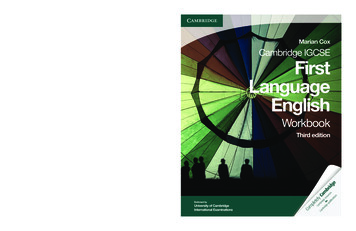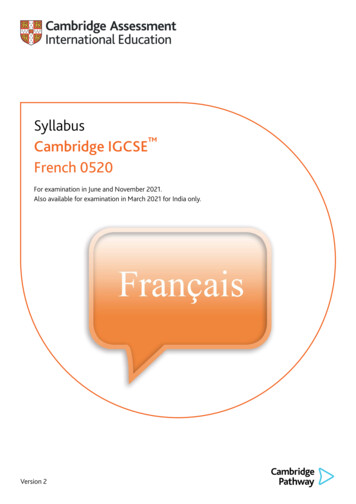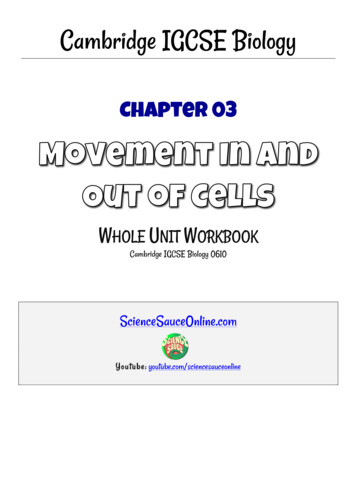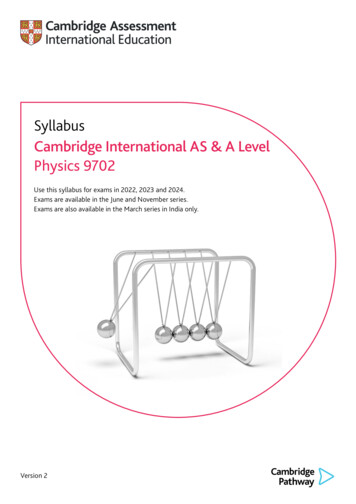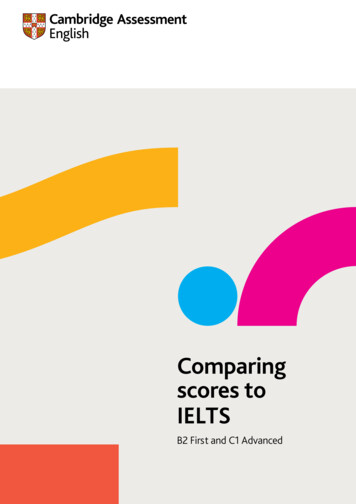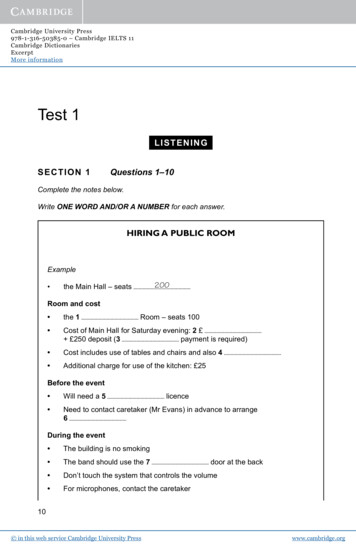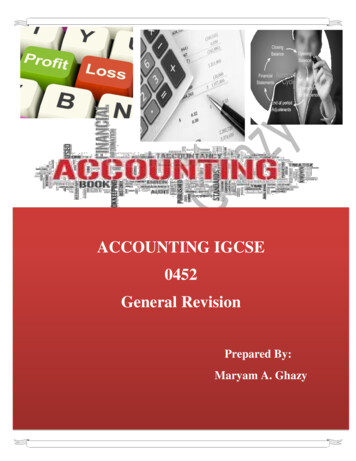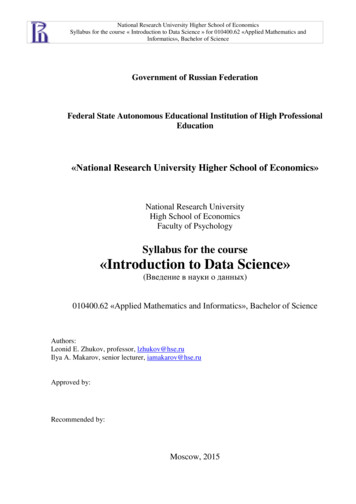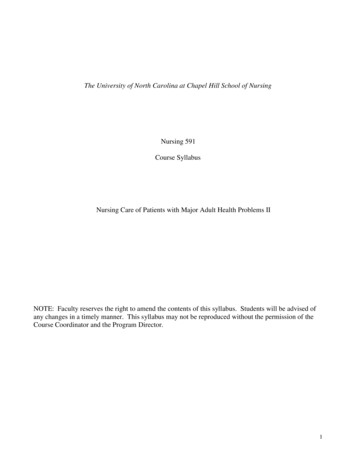
Transcription
SyllabusCambridge IGCSE Combined Science 0653Use this syllabus for exams in 2022.Exams are available in the June and November series.Exams are also available in the March series in India only.Version 1
Why choose Cambridge International?Cambridge International prepares school students for life, helping them develop an informed curiosity and a lastingpassion for learning. We are part of the University of Cambridge.Our Cambridge Pathway gives students a clear path for educational success from age 5 to 19. Schools can shapethe curriculum around how they want students to learn – with a wide range of subjects and flexible ways to offerthem. It helps students discover new abilities and a wider world, and gives them the skills they need for life, so theycan achieve at school, university and work.Our programmes and qualifications set the global standard for international education. They are created by subjectexperts, rooted in academic rigour and reflect the latest educational research. They provide a strong platform forlearners to progress from one stage to the next, and are well supported by teaching and learning resources.Our mission is to provide educational benefit through provision of international programmes and qualifications forschool education and to be the world leader in this field. Together with schools, we develop Cambridge learnerswho are confident, responsible, reflective, innovative and engaged – equipped for success in the modern world.Every year, nearly a million Cambridge students from 10 000 schools in 160 countries prepare for their future withthe Cambridge Pathway.‘We think the Cambridge curriculum is superb preparation for university.’Christoph Guttentag, Dean of Undergraduate Admissions, Duke University, USAQuality managementCambridge International is committed to providing exceptional quality. In line with this commitment, ourquality management system for the provision of international qualifications and education programmesfor students aged 5 to 19 is independently certified as meeting the internationally recognised standard,ISO 9001:2015. Learn more at www.cambridgeinternational.org/ISO9001Copyright UCLES September 2019Cambridge Assessment International Education is part of the Cambridge Assessment Group. Cambridge Assessment is the brand name ofthe University of Cambridge Local Examinations Syndicate (UCLES), which itself is a department of the University of Cambridge.UCLES retains the copyright on all its publications. Registered centres are permitted to copy material from this booklet for their owninternal use. However, we cannot give permission to centres to photocopy any material that is acknowledged to a third party even forinternal use within a centre.
Contents1 Why choose this syllabus? .32 Syllabus overview .6Aims6Content overview7Assessment overview8Assessment objectives93 Subject content . 11Biology11Chemistry23Physics334 Details of the assessment . 43Core assessment43Extended assessment43Practical assessment44Glossary of terms used in science papers495 Appendix. 50Electrical symbols50Symbols and units for physical quantities51Notes for use in qualitative analysis52The Periodic Table54Safety in the laboratory55Mathematical requirements55Presentation of data56ICT opportunities57Conventions (e.g. signs, symbols, terminology and nomenclature)57
6 What else you need to know . 58Before you start58Making entries59After the exam60How students and teachers can use the grades61Grade descriptions61Changes to this syllabus for 202262Changes to this syllabusFor information about changes to this syllabus for 2022, go to page 62.The latest syllabus is version 1, published September 2019.Any textbooks endorsed to support the syllabus for examination from 2019 are still suitable for use with thissyllabus.
Cambridge IGCSE Combined Science 0653 syllabus for 2022.1 Why choose this syllabus?Key benefitsCambridge IGCSE is the world’s most popular international qualification for 14 to 16 year olds, although it can betaken by students of other ages. It is tried, tested and trusted.Students can choose from 70 subjects in any combination – it is taught by over 4700 schools in 150 countries.Our programmes balance a thorough knowledge and understanding of a subject and help to develop the skillslearners need for their next steps in education or employment.Cambridge IGCSE Combined Science enables learners to: increase their understanding of the technological world take an informed interest in scientific matters recognise the usefulness (and limitations) of scientific method, and how to apply this to other disciplines and ineveryday life develop relevant attitudes, such as a concern for accuracy and precision, objectivity, integrity, enquiry, initiativeand inventiveness develop an interest in, and care for, the environment better understand the influence and limitations placed on scientific study by society, economy, technology,ethics, the community and the environment develop an understanding of the scientific skills essential for both further study and everyday life.Our approach encourages learners to be:Cambridgelearner‘The strength of Cambridge IGCSE qualifications is internationally recognised and has providedan international pathway for our students to continue their studies around the world.’Gary Tan, Head of Schools and CEO, Raffles International Group of Schools, IndonesiaBack to contents pagewww.cambridgeinternational.org/igcse3
Cambridge IGCSE Combined Science 0653 syllabus for 2022. Why choose this syllabus?International recognition and acceptanceOur expertise in curriculum, teaching and learning, and assessment is the basis for the recognition of ourprogrammes and qualifications around the world. The combination of knowledge and skills in Cambridge IGCSECombined Science gives learners a solid foundation for further study. Candidates who achieve grades A* to C arewell prepared to follow a wide range of courses including Cambridge International AS & A Level science subjects.Cambridge IGCSEs are accepted and valued by leading universities and employers around the world as evidence ofacademic achievement. Many universities require a combination of Cambridge International AS & A Levels andCambridge IGCSEs or equivalent to meet their entry requirements.UK NARIC, the national agency in the UK for the recognition and comparison of international qualifications andskills, has carried out an independent benchmarking study of Cambridge IGCSE and found it to be comparable tothe standard of GCSE in the UK. This means students can be confident that their Cambridge IGCSE qualificationsare accepted as equivalent to UK GCSEs by leading universities worldwide.Learn more at e Assessment International Education is an education organisation and politically neutral. Thecontent of this syllabus, examination papers and associated materials do not endorse any political view. Weendeavour to treat all aspects of the exam process neutrally.‘Cambridge IGCSE is one of the most sought-after and recognised qualifications in the world. Itis very popular in Egypt because it provides the perfect preparation for success at advanced levelprogrammes.’Managing Director of British School in Egypt BSE4www.cambridgeinternational.org/igcseBack to contents page
Cambridge IGCSE Combined Science 0653 syllabus for 2022. Why choose this syllabus?Supporting teachersWe provide a wide range of practical resources, detailed guidance, and innovative training and professionaldevelopment so that you can give your students the best possible preparation for Cambridge IGCSE.Teaching resourcesExam preparation resources . School Support Hubwww.cambridgeinternational.org/support . Question papers .Syllabuses . Schemes of work . Example candidate responses to understandwhat examiners are looking for at key grades . Learner guides . Examiner reports to improve future teaching . Mark schemes . Discussion forums . Endorsed resourcesTraining . Introductory – face-to-face or online . Extension – face-to-face or online . Enrichment – face-to-face or online . Coursework – online . Cambridge Professional DevelopmentQualificationsSupport forCambridgeIGCSECommunityYou can find useful information, as well asshare your ideas and experiences with otherteachers, on our social media channels andcommunity forums.Find out more atwww.cambridgeinternational.org/social-mediaFind out more atwww.cambridgeinternational.org/profdevBack to contents pagewww.cambridgeinternational.org/igcse5
Cambridge IGCSE Combined Science 0653 syllabus for 2022.2 Syllabus overviewAimsThe aims describe the purposes of a course based on this syllabus.You can deliver some of the aims using suitable local, international or historical examples and applications, orthrough collaborative experimental work.The aims are to: provide an enjoyable and worthwhile educational experience for all learners, whether or not they go on tostudy science beyond this level enable learners to acquire sufficient knowledge and understanding to:–become confident citizens in a technological world and develop an informed interest in scientific matters–be suitably prepared for studies beyond Cambridge IGCSE allow learners to recognise that science is evidence-based and understand the usefulness, and the limitations,of scientific method develop skills that:–are relevant to the study and practice of science–are useful in everyday life–encourage a systematic approach to problem-solving–encourage efficient and safe practice–encourage effective communication through the language of science develop attitudes relevant to science such as:–concern for accuracy and itiative–inventiveness enable learners to appreciate that:–science is subject to social, economic, technological, ethical and cultural influences and limitations–the applications of science may be both beneficial and detrimental to the individual, the community andthe environment.Support for Cambridge IGCSE Combined ScienceThe School Support Hub is our secure online site for Cambridge teachers where you can find the resourcesyou need to deliver our programmes, including schemes of work, past papers, mark schemes and examinerreports. You can also keep up to date with your subject and the global Cambridge community through ouronline discussion cambridgeinternational.org/igcseBack to contents page
Cambridge IGCSE Combined Science 0653 syllabus for 2022. Syllabus overviewContent overviewThe subject content is divided into three sections: Biology (B1–B12), Chemistry (C1–C12) and Physics (P1–P6).Candidates must study all three sections.BiologyB1Characteristics of living organismsB2CellsB3Biological moleculesB4EnzymesB5Plant nutritionB6Animal nutritionB7TransportB8Gas exchange and respirationB9Coordination and responseB10ReproductionB11Organisms and their environmentB12Human influences on ecosystemsChemistryC1The particulate nature of matterC2Experimental techniquesC3Atoms, elements and compoundsC4StoichiometryC5Electricity and chemistryC6Energy changes in chemical reactionsC7Chemical reactionsC8Acids, bases and saltsC9The Periodic TableC10MetalsC11Air and waterC12Organic chemistryPhysicsP1MotionP2Work, energy and powerP3Thermal physicsP4Properties of waves, including light and soundP5Electrical quantitiesP6Electric circuitsBack to contents pagewww.cambridgeinternational.org/igcse7
Cambridge IGCSE Combined Science 0653 syllabus for 2022. Syllabus overviewAssessment overviewAll candidates take three papers.Candidates who have studied the Core subject content, or who are expected to achieve a grade D or below, shouldbe entered for Paper 1, Paper 3 and either Paper 5 or Paper 6. These candidates will be eligible for grades C to G.Candidates who have studied the Extended subject content (Core and Supplement), and who are expected toachieve a grade C or above, should be entered for Paper 2, Paper 4 and either Paper 5 or Paper 6. These candidateswill be eligible for grades A* to G.Core candidates take:Extended candidates take:Paper 1Multiple Choice (Core)45 minutes30%Paper 2Multiple Choice (Extended)45 minutes30%40 marks40 marks40 four-option multiple-choice questions40 four-option multiple-choice questionsQuestions will be based on the Core subjectcontent.Questions will be based on the Extendedsubject content (Core and Supplement).Externally assessedExternally assessedand Core candidates take:and Extended candidates take:Paper 3Theory (Core)1 hour 15 minutes50%Paper 4Theory (Extended)1 hour 15 minutes50%80 marks80 marksShort-answer and structured questionsShort-answer and structured questionsQuestions will be based on the Core subjectcontent.Questions will be based on the Extendedsubject content (Core and Supplement).Externally assessedExternally assessedAll candidates takeeither:or:Paper 5Practical Test1 hour 15 minutes20%Paper 6Alternative to Practical1 hour20%40 marks40 marksQuestions will be based on the experimentalskills in section 4.Questions will be based on the experimentalskills in section 4.Externally assessedExternally assessedInformation on availability is in the Before you start section.8www.cambridgeinternational.org/igcseBack to contents page
Cambridge IGCSE Combined Science 0653 syllabus for 2022. Syllabus overviewAssessment objectivesThe assessment objectives (AOs) are:AO1 Knowledge with understandingCandidates should be able to demonstrate knowledge and understanding of: scientific phenomena, facts, laws, definitions, concepts and theories scientific vocabulary, terminology and conventions (including symbols, quantities and units) scientific instruments and apparatus, including techniques of operation and aspects of safety scientific and technological applications with their social, economic and environmental implications.Subject content defines the factual material that candidates may be required to recall and explain. Candidates willalso be asked questions which require them to apply this material to unfamiliar contexts and to apply knowledgefrom one area of the syllabus to another.Questions testing this assessment objective will often begin with one of the following words: define, state, describe,explain (using your knowledge and understanding) or outline (see the Glossary of terms used in science papers).AO2 Handling information and problem-solvingCandidates should be able, in words or using other written forms of presentation (i.e. symbolic, graphical andnumerical), to: locate, select, organise and present information from a variety of sources translate information from one form to another manipulate numerical and other data use information to identify patterns, report trends and draw inferences present reasoned explanations for phenomena, patterns and relationships make predictions and hypotheses solve problems, including some of a quantitative nature.Questions testing these skills may be based on information that is unfamiliar to candidates, requiring them to applythe principles and concepts from the syllabus to a new situation, in a logical, deductive way.Questions testing these skills will often begin with one of the following words: predict, suggest, calculate ordetermine (see the Glossary of terms used in science papers).AO3 Experimental skills and investigationsCandidates should be able to: demonstrate knowledge of how to safely use techniques, apparatus and materials (including following asequence of instructions where appropriate) plan experiments and investigations make and record observations, measurements and estimates interpret and evaluate experimental observations and data evaluate methods and suggest possible improvements.Back to contents pagewww.cambridgeinternational.org/igcse9
Cambridge IGCSE Combined Science 0653 syllabus for 2022. Syllabus overviewWeighting for assessment objectivesThe approximate weightings allocated to each of the assessment objectives (AOs) are summarised below.Assessment objectives as a percentage of the qualificationAssessment objectiveWeighting in IGCSE %AO1 Knowledge with understanding50AO2 Handling information and problem-solving30AO3 Experimental skills and investigations20Total100Assessment objectives as a percentage of each componentAssessment objectivePapers1 and 2Papers3 and 4Papers5 and 6AO1 Knowledge with understanding63630AO2 Handling information and problem-solving37370AO3 Experimental skills and investigations00100100100100Total10Weighting in components %www.cambridgeinternational.org/igcseBack to contents page
Cambridge IGCSE Combined Science 0653 syllabus for 2022.3 Subject contentThe subject content that follows is divided into three sections: Biology (B1–B12), Chemistry (C1–C12) and Physics(P1–P6). Candidates must study all three sections.All candidates should be taught the Core subject content. Candidates who are only taught the Core subject contentcan achieve a maximum of grade C. Candidates aiming for grades A* to C should be taught the Extended subjectcontent. The Extended subject content includes both the Core and the Supplement.This syllabus gives you the flexibility to design a course that will interest, challenge and engage your learners.Where appropriate you are responsible for selecting suitable subject contexts, resources and examples to supportyour learners’ study. These should be appropriate for the learners’ age, cultural background and learning context aswell as complying with your school policies and local legal requirements.Scientific subjects are, by their nature, experimental. Learners should pursue a fully integrated course which allowsthem to develop their practical skills by carrying out practical work and investigations within all of the topics listed.BiologyB1Characteristics of living organismsB1.1Characteristics of living organismsCore1Describe the characteristics of living organismsby defining the terms:–– movement as an action by an organismcausing a change of position or place–– respiration as the chemical reactions in cellsthat break down nutrient molecules andrelease energy–– sensitivity as the ability to detect and respondto changes in the environment–– growth as a permanent increase in size–– reproduction as the processes that makemore of the same kind of organism–– excretion as removal from organisms oftoxic materials and substances in excess ofrequirements–– nutrition as taking in of materials for energy,growth and developmentBack to contents pagewww.cambridgeinternational.org/igcse11
Cambridge IGCSE Combined Science 0653 syllabus for 2022. Subject content0653 BiologyB2CellsB2.1Cell structureSupplementCore1State that living organisms are made of cells2Describe and compare the structure of a plantcell with an animal cell, as seen under a lightmicroscope, limited to cell wall, nucleus,cytoplasm, chloroplasts, vacuoles and location ofthe cell membrane3State the functions of the structures seen underthe light microscope in the plant cell and in theanimal cell4Relate the structure of the following to theirfunctions:–– c iliated cells – movement of mucus in thetrachea and bronchi–– root hair cells – absorption–– palisade mesophyll cells – photosynthesis–– red blood cells – transport of oxygen–– sperm and egg cells – reproduction5Calculate magnification and size of biologicalspecimens using millimetres as unitsB2.2Movement in and out of cellsCore121Define diffusion as the net movement of particlesfrom a region of their higher concentration toa region of their lower concentration downa concentration gradient, as a result of theirrandom movement2State that substances move into and out of cellsby diffusion through the cell membrane3State that water diffuses through partiallypermeable membranes by osmosis5State that water moves in and out of cells byosmosis through the cell membrane6Investigate and describe the effects on planttissues of immersing them in solutions ofdifferent Supplement4Define osmosis as the net movement of watermolecules from a region of higher waterpotential (dilute solution) to a region of lowerwater potential (concentrated solution), througha partially permeable membraneBack to contents page
Cambridge IGCSE Combined Science 0653 syllabus for 2022. Subject content0653 BiologyB3Biological moleculesB3.1Biological moleculesCore1List the chemical elements that make up:–– carbohydrates–– fats–– proteins2State that large molecules are made from smallermolecules, limited to:–– starch and glycogen from glucose–– proteins from amino acids–– fats and oils from fatty acids and glycerol3Describe the use of:–– iodine solution to test for starch–– B enedict’s solution to test for reducingsugars–– biuret test for proteins–– ethanol emulsion test for fats and oils4State that water is important as a solventB4EnzymesB4.1EnzymesCoreSupplement1Define enzymes as proteins that function asbiological catalysts2Explain enzyme action with reference to thecomplementary shape of the active site of anenzyme and its substrate and the formation of aproduct3Investigate and describe the effect of changes intemperature and pH on enzyme activity4Explain the effect of changes in temperature onenzyme activity, in terms of kinetic energy, shapeand fit, frequency of effective collisions anddenaturation5Explain the effect of changes in pH onenzyme activity in terms of shape and fit anddenaturationBack to contents pagewww.cambridgeinternational.org/igcse13
Cambridge IGCSE Combined Science 0653 syllabus for 2022. Subject content0653 BiologyB5Plant nutritionB5.1Plant nutritionCore1Define photosynthesis as the process by whichplants manufacture carbohydrates from rawmaterials using energy from light2State the word equation for photosynthesis:carbon dioxide water glucose oxygen,in the presence of light and chlorophyllSupplement3State the balanced equation for photosynthesis6CO 2 6H 2OlightchlorophyllC 6 H 12 O 6 6O 24Explain that chlorophyll transfers light energyinto chemical energy in molecules, for thesynthesis of carbohydrates5Outline the subsequent use and storage of thecarbohydrates made in photosynthesis6Investigate the necessity for chlorophyll, lightand carbon dioxide for photosynthesis, usingappropriate controls7Investigate and describe the effect of varyinglight intensity and temperature on the rate ofphotosynthesis (e.g. in submerged aquatic plants)8Identify chloroplasts, cuticle, guard cells andstomata, upper and lower epidermis, palisademesophyll, spongy mesophyll, vascular bundles,xylem and phloem in leaves of a dicotyledonousplant9Describe the significance of the features of a leafin terms of functions, to include:–– p alisade mesophyll and distribution ofchloroplasts – photosynthesis–– s tomata, spongy mesophyll cells and guardcells – gas exchange–– xylem for transport and support–– phloem for transport10 Describe the importance of:–– nitrate ions for making amino acids11 Explain the effects of nitrate ion and magnesiumion deficiency on plant growth–– magnesium ions for making ack to contents page
Cambridge IGCSE Combined Science 0653 syllabus for 2022. Subject content0653 BiologyB6Animal nutritionB6.1DietSupplementCore1State what is meant by the term balanced diet forhumans2List the principal sources of, and describe thedietary importance of:3Explain how age, gender and activity affectthe dietary needs of humans including duringpregnancy and whilst breast-feeding4Describe the effects of malnutrition in relation tostarvation, constipation, coronary heart disease,obesity and scurvy5Explain the causes and effects of vitamin D andiron deficiencies–– carbohydrates–– fats–– proteins–– vitamins, limited to C and D–– mineral salts, limited to calcium and iron–– fibre (roughage)–– waterB6.2Alimentary canalCore1Define ingestion as the taking of substances, e.g.food and drink, into the body through the mouth2Define digestion as the breakdown of large,insoluble food molecules into small, watersoluble molecules using mechanical and chemicalprocesses5Define absorption as the movement of smallfood molecules and ions through the wall of theintestine into the blood6Define egestion as the passing out of food thathas not been digested or absorbed, as faeces,through the anus7Identify the main regions of the alimentary canaland associated organs, limited to mouth, salivaryglands, oesophagus, stomach, small intestine,pancreas, liver, gall bladder, large intestine andanus8Describe the functions of the regions of thealimentary canal listed above, in relation toingestion, digestion, absorption and egestion offoodBack to contents pageSupplement3Define mechanical digestion as the breakdown offood into smaller pieces without chemical changeto the food molecules4Define chemical digestion as the breakdown oflarge, insoluble molecules into small, se15
Cambridge IGCSE Combined Science 0653 syllabus for 2022. Subject content0653 BiologyB6.3DigestionCoreSupplement12State the significance of chemical digestion inthe alimentary canal in producing small, solublemolecules that can be absorbedState the functions of enzymes as follows:–– a mylase breaks down starch to simplersugars–– protease breaks down protein to amino acids–– l ipase breaks down fats to fatty acids andglycerolB7TransportB7.1Transport in plantsCore161State the functions of xylem and phloem2Identify the position of xylem as seen in sectionsof roots, stems and leaves, limited to non-woodydicotyledonous plants3Identify root hair cells, as seen under the lightmicroscope, and state their functions5State the pathway taken by water through root,stem and leaf as root hair cells, root cortex cells,xylem and mesophyll cells6Investigate, using a suitable stain, the pathway ofwater through the above-ground parts of a plant7State that water is transported from the roots toleaves through the xylem vessels8Define transpiration as loss of water vapourfrom plant leaves by evaporation of water atthe surfaces of the mesophyll cells followed bydiffusion of water vapour through the stomata9Investigate and describe the effects of variationof temperature and humidity on cse3State where, in the alimentary canal, amylase,protease and lipase are secreted4State the functions of the hydrochloric acid ingastric juice, limited to killing bacteria in foodand giving an acid pH for enzymesSupplement4Explain that the large surface area of root hairsincreases the rate of the absorption of water10 Explain the effects of variation of temperatureand humidity on transpiration rateBack to contents page
Cambridge IGCSE Combined Science 0653 syllabus for 2022. Subject content0653 BiologyB7.2Transport in mammalsCoreSupplement12Describe double circulation in terms ofcirculation to the lungs and circulation to thebody tissues in mammals3Explain the advantages of a double circulationDescribe the circulatory system as a system ofblood vessels with a pump and valves to ensureone-way flow of blood4Name and identify the structures of themammalian heart, limited to the muscular wall,the septum, the left and right ventricles and atria,one-way valves and coronary arteries5State that blood is pumped away from the heartinto arteries and returns to the heart in veins6Describe the functioning of the heart in termsof the contraction of muscles of the atria andventricles and the action of the valves7Name the main blood vessels to and from the:8Describe coronary heart disease in terms ofthe blockage of coronary arteries and state thepossible risk factors as diet, stress, smoking,genetic predisposition, age and gender–– h eart, limited to vena cava, aorta, pulmonaryartery and pulmonary vein–– l ungs, limited to the pulmonary artery andpulmonary vein9Investigate and state the effect of physicalactivity on pulse rate11 Describe the structure and functions of arteries,veins and capillaries10 Explain the effect of physical activity on the heartrate12 Explain how the structures of arteries, veins andcapillaries are adapted for their function13 List the components of blood as red blood cells,white blood cells, platelets and plasma14 Identify red and white blood cells, as seen underthe light microscope, on prepared slides and indiagrams and photomicrographs15 State the functions of the following componentsof blood:–– r ed blood cells in transporting oxygen,including the role of haemoglobin–– w hite blood cells in phagocytosis andantibody production–– platelets in clotting (details are not required)–– p lasma in the transport of blood cells, ions,soluble nutrients, hormones and carbondioxideBack to contents pagewww.cambridgeinternational.org/igcse17
Cambridge IGCSE Combined Science 0653 syllabus for 2022. Subject content0653 BiologyB8Gas exchange and respirationB8.1Gas exchangeCoreSupplement1Name and identify the lungs, diaphragm, ribs,intercostal muscles, larynx, trachea, bronchi,bronchioles, alveoli and associated capillaries2List the features of gas exchange surfaces inanimals, limited to large surface area, thinsurface, good blood supply and good ventilationwith air3State the d
Combined Science 0653 Use this syllabus for exams in 2022. Exams are available in the June and November series. . reflective, innovative and engaged – equipped for success in the modern world. Every year, nearly a million Cambridge students from 10 000 schools in 160 count

